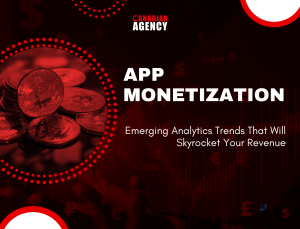Like the majority of app developers, you should consider monetization daily. Most certainly, you’ve experimented with the typical models—such as one-time purchases, subscriptions, and in-app advertisements. However, have you ever had the impression that you’re losing money? Does your app have untapped potential that is simply waiting to be discovered?
For years, we’ve relied on surface-level metrics: downloads, daily active users, and overall revenue. While these numbers tell a story, they don’t provide the blueprint for growth. The real secret to skyrocketing your app’s revenue isn’t just about what monetization model you choose; it’s about how you understand the people using your app.
The game has changed. A new wave of analytical approaches is empowering developers to move beyond guesswork and into the realm of predictive, personalized user engagement. This isn’t about complex jargon; it’s about more brilliant insights. Let’s examine the five new analytics trends that astute developers are using to transform their apps into revenue-generating machines.
1. Predictive Analytics: Your Crystal Ball for User Behavior
Imagine you could peer into the future and know which of your users is most likely to make a purchase next week. Or, conversely, which valuable users are quietly preparing to leave forever. This is no longer a fantasy; it’s the power of predictive analytics.
In Simple Terms:
Predictive analytics uses your existing user data to forecast future actions. By applying intelligent algorithms, it identifies patterns that the human eye would easily miss. It answers the critical question: “What is this user likely to do next?”
How This Boosts Your Revenue:
- Precision-Timed Offers: Instead of blasting every user with the same promotion, you can target individuals who are on the cusp of converting. For instance, if a user has browsed a specific feature multiple times but hasn’t upgraded, a predictive model can flag them for a perfectly timed, personalized discount.
- Proactive Churn Prevention: What if you could save a user before they leave? Predictive analytics identifies users exhibiting “at-risk” behaviors—like declining session time or ignoring key features. You can then engage them with a special message, offer, or content to reignite their interest.
- Smarter Marketing Spending: By forecasting the lifetime value of different user segments, you can stop wasting money on users who drain support resources and never pay. Alternatively, you might allocate your advertising spend on attracting more people who resemble your high-value champions in appearance and behavior.
Getting Started:
You don’t need a PhD in data science. Many modern analytics platforms now have built-in predictive features. Start by asking a simple question: “Who is most likely to cancel their subscription this month?” Your tools can help you find the answer.
2. Cohort Analysis: See Beyond the “Average” Illusion
Looking at your overall Average Revenue Per User (ARPU) is like calculating the average temperature in a hospital. It doesn’t tell you which patients are healthy and which are in critical condition. Cohort analysis breaks down this average to reveal the true story.
In Simple Terms:
A cohort is simply a group of users who share a common characteristic, typically the date they installed your app. Cohort analysis tracks the behavior of these specific groups over their lifetime.
How This Boosts Your Revenue:
- Measure Feature Impact with Precision: Did that new feature you launched actually drive more sales? By comparing the spending habits of users who joined after the launch (a new cohort) with those from before, you get a clear picture of its real impact.
- Uncover Your Best Marketing Channels: Which ad campaign brought you the most valuable users? A cohort analysis can reveal that users from a pricier Instagram campaign might have a much higher long-term value than users from a cheaper source, making the initial cost a brilliant investment.
- Identify Hidden Friction Points: You might discover that users who signed up in March have a sharp revenue drop-off after 30 days. This prompts you to investigate what happens at that one-month mark—is there a confusing paywall? A missing tutorial?
Getting Started:
In your analytics dashboard, create a cohort report grouped by “Week of Install” and track their revenue over eight weeks. The visual will instantly show you if your newer users are more valuable than your older ones, and why.
3. Funnel and Path Analysis: Mapping the User’s Journey to “Yes”
Every user takes a path through your app. Some trails lead directly to a purchase. Others lead to a dead end. Your goal is to understand both.
In Simple Terms:
- Funnel Analysis: You define a desired path (e.g., Open App -> View Product -> Add to Cart -> Checkout -> Purchase) and see where users abandon the journey.
- Path Analysis: This works in reverse. You start with a successful outcome (a purchase) and work backward to see the most common routes users took to get there.
How This Boosts Your Revenue:
- Fix Your Biggest Leaks: Funnel analysis pinpoints the exact step where you’re losing the most potential customers. Is it on the payment screen? During sign-up? Knowing the problem is 90% of the solution, allowing you to A/B test fixes immediately.
- Discover Your “Secret Sauce”: Path analysis might reveal that your biggest spenders all used a specific, non-obvious feature before making a purchase. You can then guide more users toward that feature, effectively creating a new highway to revenue.
- Optimize Ad and Promotion Placement: If you find that users who visit the “Learn” section convert at a high rate, that’s a prime spot to promote your premium subscription or a strategic ad.
Getting Started:
Define your most critical monetization funnel. It could be for a subscription, an in-app purchase, or even viewing a rewarded ad. Visualize this funnel and tackle the step with the highest drop-off rate first.
4. Sentiment Analysis: Listen to the Words Behind the Numbers
Data tells you what users are doing, but their words tell you why. Ignoring user feedback is like flying a plane without looking out the window.
In Simple Terms:
Sentiment analysis involves scanning user-generated text—like app store reviews, support tickets, and survey responses—to automatically gauge whether the feedback is positive, negative, or neutral, and to identify common themes.
How This Boosts Your Revenue:
- Turn Complaints into Opportunities: A surge of negative reviews about a specific bug isn’t just a problem—it’s a clear directive for your development team. Fixing it quickly can prevent a mass exodus and protect your revenue stream.
- Build Features People Will Pay For: What are your most loyal users consistently requesting in their reviews? These are not just suggestions; they are a validated roadmap for features that will drive upgrades and retention.
- Refine Your Messaging: If users describe your app’s value using different words than your marketing team, you have a golden opportunity to adjust your language on the app store and within the app to connect better and convert.
Getting Started:
Make use of a program that compiles and evaluates your app store reviews. Spend half an hour every week reading a few 5-star and 1-star reviews. The qualitative information will be invaluable.
5. Privacy-First Analytics: Building Trust is the Ultimate Strategy
The era of collecting every possible data point is over. With growing user awareness and new platform regulations, building trust through transparency is no longer optional—it’s a competitive advantage.
In Simple Terms:
This trend focuses on collecting data responsibly, with explicit user consent, and relying more on the high-quality information you gather directly from your users (first-party data) rather than buying it from others.
How This Boosts Your Revenue:
- Trust Drives Spending: Users who trust you with their data are more likely to engage deeply, subscribe, and make in-app purchases. Being a privacy-conscious app is a powerful brand statement.
- Better Data, Better Decisions: First-party data is far more accurate and reliable than third-party data. This means the insights you get about your users’ behavior are truthful, leading to smarter business choices.
- Future-Proof Your Revenue Streams: Adapting to a privacy-centric world now ensures that your monetization strategies won’t be suddenly disrupted by the next iOS update or new government regulation.
Getting Started:
Examine the data collection methods used by your app. Your privacy policy should be very explicit about what you gather and why. Above all, present a clear value exchange: “Give us insight into your usage so we can give you a more helpful and personalized experience.”
The Symphony of Success
The true magic happens when these trends work together. Imagine using path analysis to discover a hidden path to purchase, cohort analysis to confirm which user groups take it, and predictive analytics to gently guide new users onto that same profitable journey.
This is the new frontier of app monetization. It’s a shift from seeing users as data points to understanding them as individuals with unique needs and behaviors. By embracing these deeper analytical approaches, you stop just tracking revenue and start actively building it.
Your app has untapped potential. It’s time to use these emerging trends to listen, learn, and unlock them.




